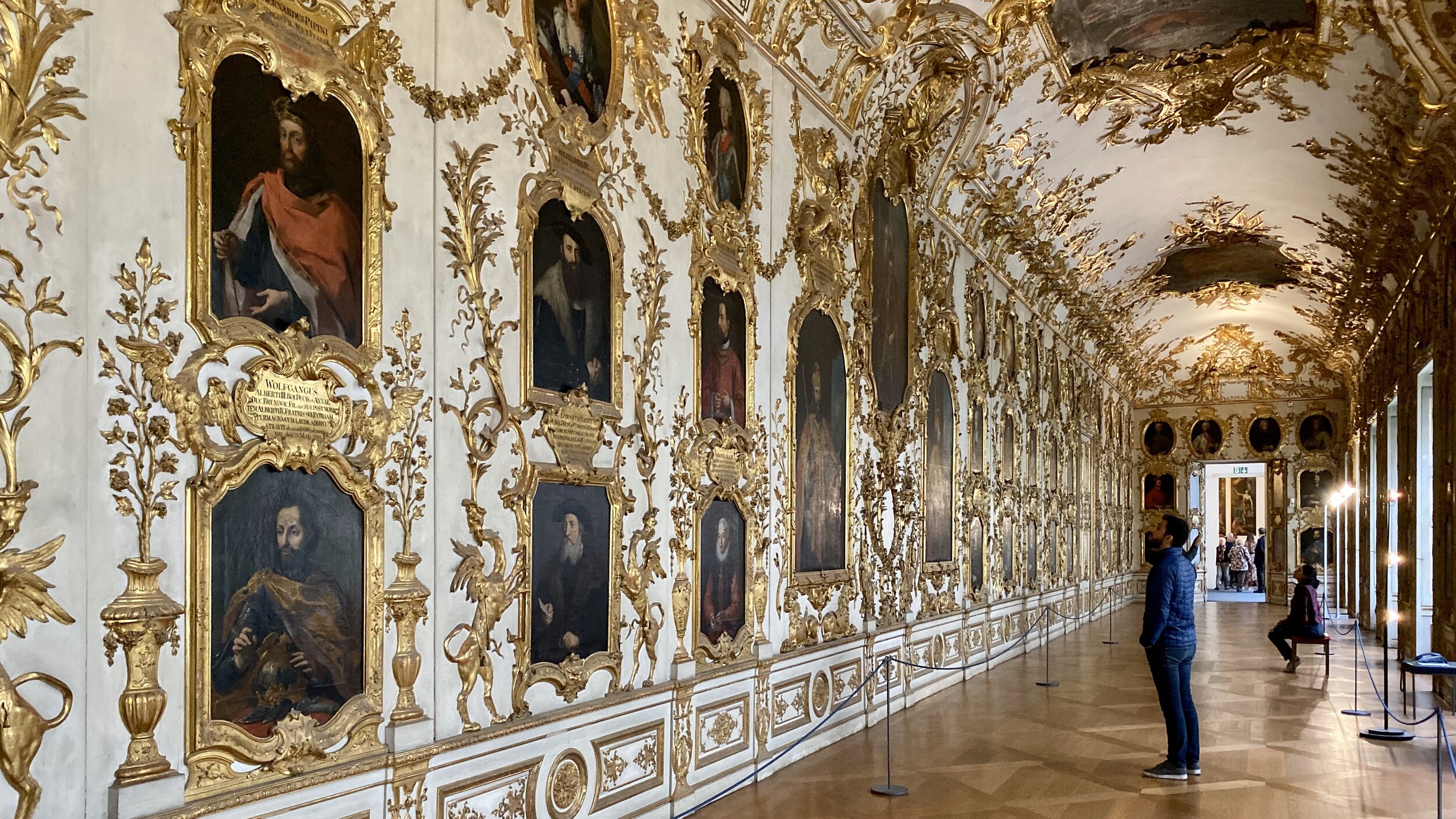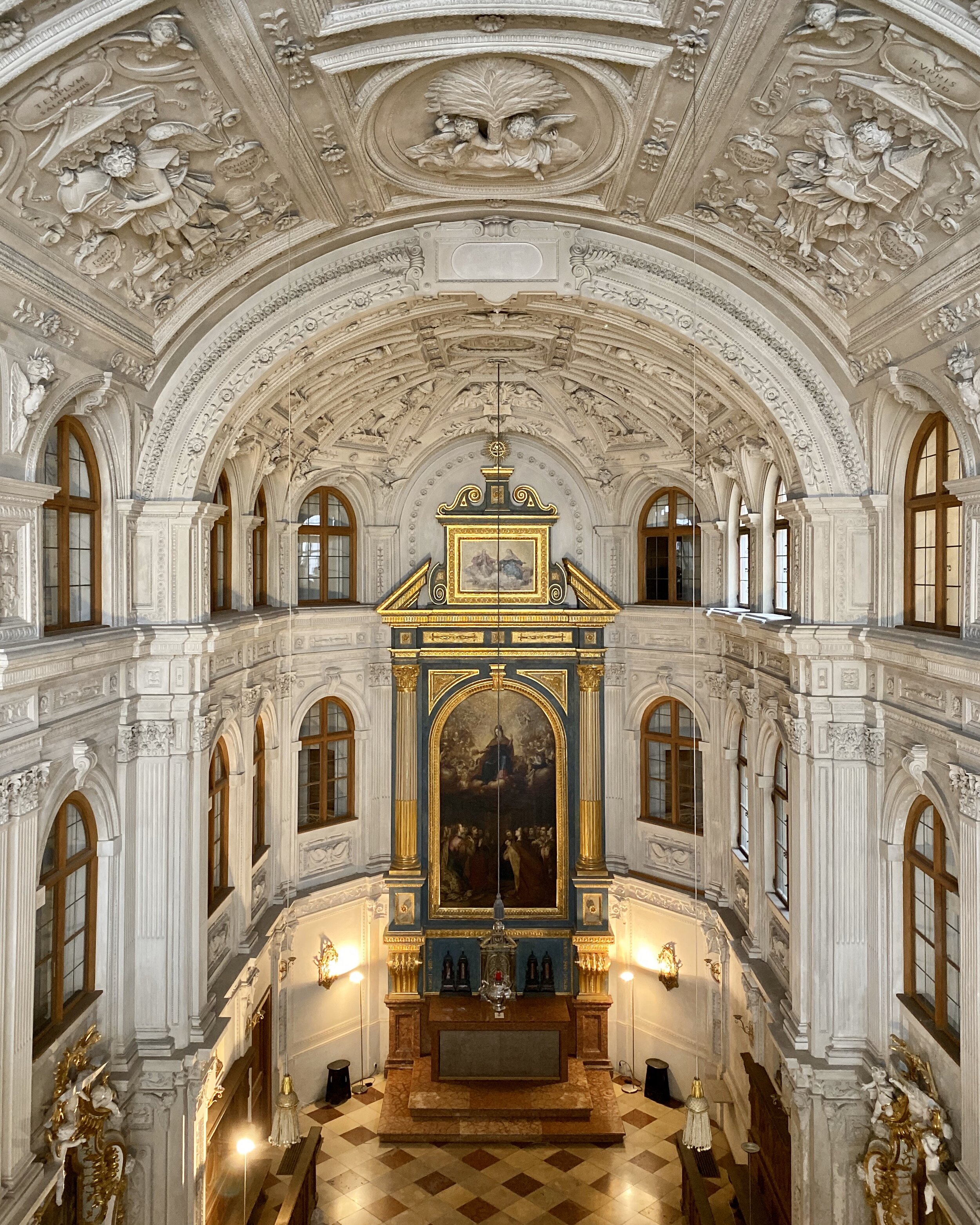Munich, 21 Oct 2019
We finished our walking tour of Munich, but first, we went through the Resident Palace. All 100 rooms of it.
This being our first morning in Munich, we decided to try out the hostel's buffet breakfast. It was pretty similar to what we had in Cologne, but quite a bit less expensive. There weren't many people there at the time, so things flowed pretty well. Guess all the Japanese women were sleeping in.
Since the Residenz has pretty tight bag restrictions, we decided to leave our larger bags in the room, go through the museum, then come back for our bags. It was only two stops, and about a block walk on each end, so that seemed like a way to not have to deal with the bag check (not knowing how busy it would be).
Residenz
The Residenz didn't open until 10am, so we had time to figure out the transit tickets (bought a multi-person day pass), which train, and where to get off. Even wandering around looking for the ticket entrance, we still made it there about 10 minutes early. We were let into the courtyard a few minutes before 10, at which time the doors to the museum opened.
Beginning in the late 14th century as a crude castle with a moat, the main building of the Residenz' was built between the mid-16th and mid-17th century, then decorated in Rococo style in the 18th century. During WWII, air raids left much of the Residenz in rubble, so much of what is seen is reconstructed.
We purchased combination tickets so we could see the Residenz Treasury, the Residenz Museum, and the Cuvilliés Theater. An audio guide was available for the Treasury and Museum, but we found ourselves using it on only a few items and even then, not listening to all the entries. There was so much to get through, we decided to pick-and-choose what to listen to.
Residenz Treasury
This is a small museum but has a lot of spectacular pieces. The Crown of Kunigunde is associated with the Bavarian queen crowned by the Holy Roman Emperor in the early 11th century. England's oldest crown, the Palatine Crown, dates back to the late 14th century. Another from the 13th century was the Crown of Henry II.
A reliquary with St. George slaying the dragon is studded with over 2,000 precious stones. Supposedly relics of St. George are in the box. Strangely, the reliquary was in an alcove with a rope across half the opening, but the case was fully enclosed and the placard so small, it seems you're meant to walk around the rope (our guide book says you can).
The crown, scepter, orb, and sword associated with the 19th-century Wittelsbach kings take center stage in another room. They were made by the same French craftsmen who created Napoleon's crown. The kings weren't actually crowned during coronations, though; the crown was brought into the room on a cushion and laid at the new monarch's feet.
Residenz Museum
While there are artifacts in the Museum, the main attractions are the rooms (90 are open to the public). The rooms are decorated with period pieces such as furniture and tapestries.
The first room is an impressive piece. The room itself is actually meant to be open to the courtyard but was closed off. The artificial grotto in this room is made of volcanic tuff and covered with Bavarian freshwater shells. Since the grotto was reconstructed after the bombings of WWII, shells were donated by small-town Bavarians. The grotto was rebuilt using photos the Nazis took; the same is true throughout the museum.
The next big room was the Antiquarium. Built in the mid-16th century, it's the oldest room in the Residenz. At over 200 feet long, the sides are lined with busts of Roman emperors. The painted arches survived the WWII bombs. They show 120 Bavarian villages as they looked at the time the room was built.
The Ancestral Gallery displays portraits of the Wittelsbachs and a family tree (shown being planted by Hercules). The paintings were cut out of their frames as WWII bombings were imminent. The painting of the walls and ceiling were restored based on photographs, but other paintings weren't photographed, so are left as black, empty spots.
With so many rooms, it's not possible to describe each one. They come in groups, such as the Electoral Apartments (private apartments of the monarch and his consort), the Charlotte Chambers and Court Garden Rooms (for visiting rulers, or later as Princess Charlotte's private rooms), Stone Rooms (named for their colorful real and fake marble), and the Ornate Rooms (Rococo decor used by the Wittelsbachs).
There are some chapels, a Reliquary Room (among other things, bones, skulls, and mummified hands in ornate cases), and rooms painted with forced perspective.
At this point, it was lunchtime, so we worked our way back to our room (picking up lunch on the way), relaxed a bit, then headed back to the Residenz with our bags.
Cuvilliés Theater
The last item on our ticket was the Cuviellés Theater. It didn't open until 2pm, which is why we had time to go back to the room. We had a little trouble finding the entrance to the theater, but after wandering through a courtyard (it looked like there were a lot of decorations, but they were all painted on), we found how to get in. As it ends up large bags did have to be checked, but it was self-service, so it was pretty quick and simple.
This Rococo theater is extremely ornate. Mozart conducted here several times. The theater itself isn't very large (seats fewer than 400), but is plush. There are four tiers of boxes with a Royal Box in the center rear. King Ludwig II was known to buy out the entire theater so he could watch performances by himself.
The original Cuviellés Theater was in a slightly different location and was leveled during WWII. Fortunately, a lot of the carved wooden interior was removed and stored away for safekeeping. So while Mozart didn't conduct in this exact theater, the lineage is still there.
Munich walking tour, continued
The stop where we left the walking tour was at Marienhof, which is currently all closed off while a new subway tunnel is built there. Marienhof is right behind Marienplatz, and there's already a lot of subway traffic in the area, so it sounds as if the new line will help.
Across the street was the Dallmayr Delicatessen. We went in and browsed around. There were all sorts of food items for sale, some pricey, some very pricey. We went to the chocolate truffle stand where several people were buying boxes of them. One customer only spoke English and was having a hard time understanding the woman behind the counter (she didn't know what a mango lassi was, and the attendant did her best trying to explain what it was; she got as far as yogurt before the customer moved on). We only got a couple truffles to share; we feel we didn't need more since they were €79/kg. They were indeed tasty.
A few blocks away was the Platzl which was completely flattened in the war. It's hard to imagine that they worked a half-century bringing things back. The exteriors were finished in time for the Munich Olympics, but the interior refurbishment wasn't finished until about 2000. There are probably hundreds of unexploded bombs still buried under the city, and they're still being found (as recently as this decade).
There was an ice cream store in the Platzl, so of course, we had to give it a try. Across the square was the Hofbräuhaus. We took a look inside; it wasn't full, but there was still a lot of activity in the middle of the afternoon. There was a band playing polkas, but they took a break while we were there.
At Max-Joseph-Platz we saw the National Theater on one side, the Residenz on another, and in the center a statue of Maximilian I (the square's namesake). He was Munich's duke until he was deposed by Napoleon. If Max Joseph's daughter married Napoleon's stepson, however, he would be reinstated. In fact, he was crowned the king of Bavaria. Before he was a constitutional monarch, but as king, he emancipated Protestants and Jews, and the National Theater was built during his reign. Four of Wagner's operas were first performed at that theater.
At Odeonsplatz, we saw an arcade filled with statues honoring Bavarian generals, modeled after the Renaissance loggia in Florence. From the plaza, we could make out the Siegestor, the city's Triumphal Arch. Beyond the arch are the Olympic Park and BMW headquarters, but they were too far to see.
We ended the walk in the Hofgarten, originally built by the Wittelsbachs as a backyard to the Residenz. The temple in the middle is 400 years old and seems to be popular with buskers (it doesn't hurt that it has really good acoustics). To Just northeast of the Hofgarten is the English Garden, which we didn't go to. It's the largest city park in Continental Europe. It's over 5 miles long and is popular with people who prefer to lie in the sun without clothes.
Rest of the day
We were done for the day, so we went back to the room to relax a bit. We ended up getting dinner at a Turkish restaurant where everything seemed pretty chaotic but we did end up with what we ordered, and it was quite good. Having done that, we were ready to settle in for the day.






























